
One of the key zones at the Lake Macquarie Variety Playground is the Circuit Zone where children can bring their small bikes, scooters and other wheeled toys. Children are free to ride around the whole playground yet this zone has sufficient appeal that there were lots of children playing here continuously.
Most early years educators know the attraction of wheeled toys. If a trike, bike or scooter is available then it is likely that there will be a child who will choose to ride it. I rarely come across a setting that has given this aspect of play much attention. Bike tracks do require a large amount of space and other zones have to be considered within an outdoor area. It can be expensive to incorporate fancy design features.
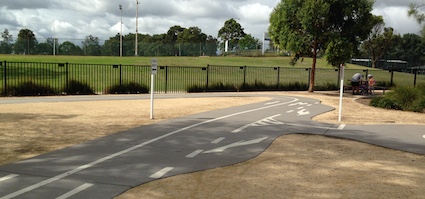
Given the time, space and financial constraints on schools and nurseries, I’m not advocating a complete makeover and re-design of your grounds. Rather, it’s good to use such examples to reflect upon what we can do with what we have got and apply the basic concepts to improve learning potential of any bike area.
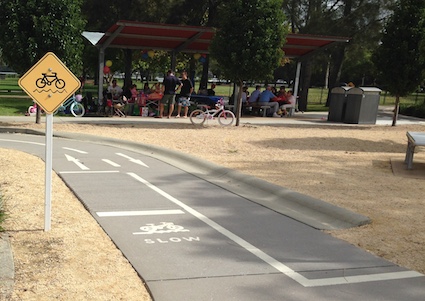
1. Make a social space near a wheeled play area
Think about what you can do to enable children to safely watch and be near to bike play without having to worry about being hit by a cyclist. In the photo above you can see the gathering place for parents and others to hang out and watch the action. There’s a parking spot for the bikes and its situation is such that bikes are unlikely to come tearing into this social space. It is quite literally just off the beaten track. The grey containers act as a block to through flow traffic.
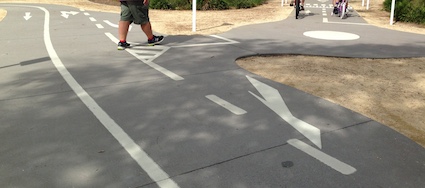
2. Change the road layouts reasonably frequently
Consider using temporary markings. Begin by experimenting through making large, thick ropes or chalk available. Children may be inspired to create their own roads especially if adults model the process. What I particularly liked about the Lake Macquarie circuit is that the road is not single track. It may impossible to have the full range of road layouts that children may encounter in their local area and arguably a static layout can restrict the play possibilities. If you want to paint designs, experiment first over several months with designs that work in your outdoor space.

3. Keep the signs and symbols fresh
Have a blank set of signs – these can be simple affairs where both staff and children can create their own signs. Have the Highway Code booklet available and the list of symbols that children can copy. Remember to let children design their own signs as part of their play, should they wish to do so. One literacy reason for bike play is to recognise and learn about the road symbols. The rectangular sign says “Mine subsidence” which is a reference to the bumpy road and the mining history of the local area.
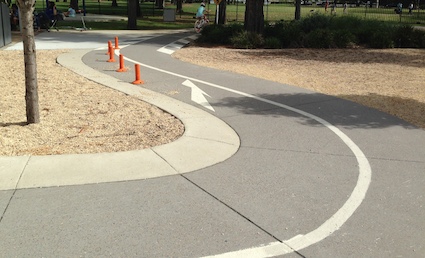
4. Offer gentle inclines
Use any inclines to good effect. A gentle slope allows children to build up a surprising amount of speed. In the above photo, the road slopes ever so slightly to the right. The sharp bend makes this part of the track more challenging than first appearances would presume. Slopes are important for developing children’s motor skills. It takes muscle strength to pedal or push a wheeled toy up a hill and it is always a delightful reward to be able to cruise down again.
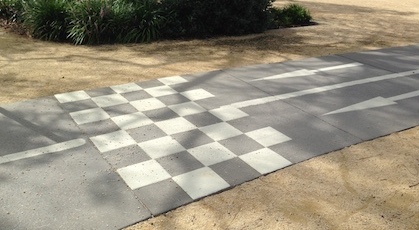
5. Create provocations
What simple provocations could be chalked onto the ground in your wheeled play area or resources placed near to the bike play area to invite the children to take their play in a new direction? I have yet to see this chequered pattern on a road. However it reminds me of Formula One racing. This seems to me that it’s a natural start and finish line for any races or time laps. Children, being children, probably use this feature in lots of imaginative ways.

6. Think about the boundaries
The edges of any bike track are interesting places and opportunities for children to learn to balance and keep on the road. You can see the water channel on the left side of the road above. Can the edges of your bike track have variety? At the Kate Greenaway Nursery, the edges of the tracks varied and provided additional physical challenges. Having a change of surface material will remind children to stay on the road and provide a different sensation should they accidentally or purposefully leave the track.
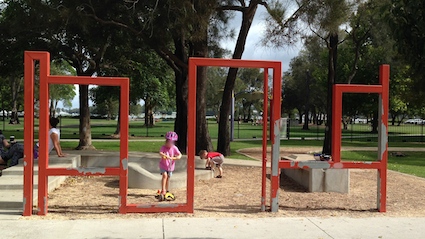
7. Consider how wheeled toys can be merged with other play
I love the simplicity of the above structure. I like that children can bring their bikes into this play area but the different surface is not conducive to wheeled toys, so the nature of how the wheeled toys are used is likely to change. If you look carefully in the above photo, you can see the slightly abstract concrete furniture – a second level, a sofa and a kitchen area.
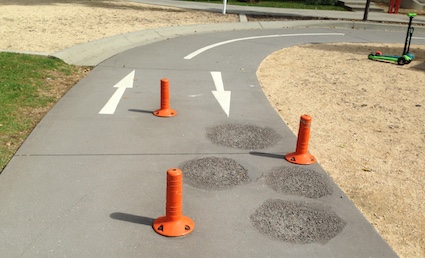
8. Create artificial surface features
When out and about in urban area, draw children’s attention to different surfaces which have different purposes. For example, at pedestrian crossings there are often bobbly tiles for people with visual impairments. Sometimes cycle lanes are different colours. Encourage the children to think how to include such features into their wheeled play zone. Watch those potholes! Whilst you may not have such artificial luxuries, you may have puddles which can be the equivalent of ford crossings and in my experience children love experimenting with different surfaces to cycle over – a bit like a wheeled sensory walk.
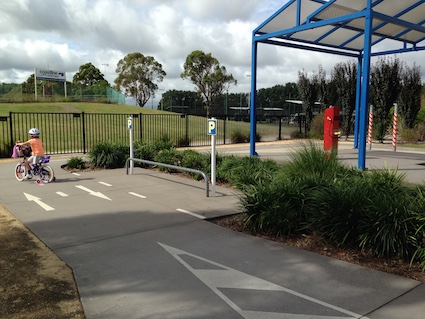
9. Build decision making into track designs
Think about building a wooden train track. Very few people choose simply to make a circle where the train is pushed round and round because it’s a wee bit dull. The fun is creating complex tracks which involve problem solving and decision-making. So having forks, roundabouts and T-junctions in the road where you have to decide which direction to go, add interest levels. Systems where you can end up in a dead end and have to turn back are good. Roads which take you to a specific destination such as a parking space beside another play zone can help transition and move play across boundaries. I always liked systems where you could end up going back over a road but travelling in the opposite direction.
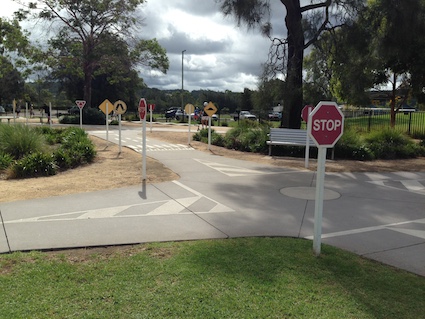
10. Think about the play purpose of traffic cones
For many children the whole point of having cones laid out within a cycling area is for the cones to be cycled into and knocked over – a wheeled game of skittles. If you wish to provide an in-and-out weaving-through-the-cones challenge then more resilient objects are needed such as planters. These can also soften the design of a bike track. Also with smaller planters, they can be moved about to change the layout of the space as children need variety.
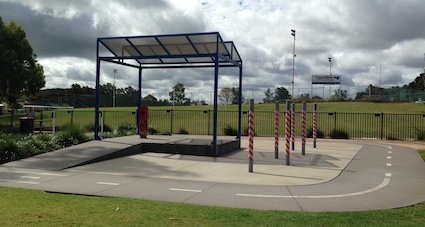
This beautifully designed playspace has left me inspired about bike play. I think what made the area particularly special was the careful landscaping within the area. Together, the vegetation and curved lines of the tracks softened the play and provided a calmer feel. Whether you work with older children undertaking cycling proficiency, have “scooter days” at play times in your primary school or have to manage an outdoor space for nursery-aged children, I hope this post has given you some food for thought.
In summary – and this applies to temporary as well as specific areas for bikes, trikes and scooters:
1. Make a social space near (but not conflicting or competing with) a wheeled play area
2. Change the road layouts reasonably frequently (if feasible to do so)
3. Keep the signs and symbols fresh
4. Offer gentle inclines
5. Create provocations
6. Think about the boundaries
7. Consider how wheeled toys can be merged with other play
8. Create artificial surface features
9. Build decision making into track designs
10. Think about the play purpose of traffic cones
This blog post is an updated version of one that was published in March 2015.




















Great to hear about this scheme, and I like the points you made. Is it a public park? Any staff?
Hi Tim
Good question. My understanding is that there’s someone who maintains the grounds – a caretaker, but no staffed play workers. It’s a public park – anyone can visit.
This looks great – and my own children would adore it, though we live in the UK, not Australia. So I’m keen to know of any equivalent places to this in Britain. Any ideas?
Hello James – Good question – someone on my Facebook page reckoned there was something like this in Falkirk but I’ve not heard of it. I will ask around & hopefully others may tell us (please add a comment if you do know of somewhere).
This would be an amazing addition to any park – my kids would love it
Little Man would absolutely love this track. I’m sure he would be there all day long finding endless ways to travel around it. Thanks so much for sharing it at the Outdoor Play Party. If only we had one nearby!
I am based in the UK and would love to recreate this in my outdoor area (I am a teacher). Do you know of anywhere I might be able to buy the grey pieces of track?
Hello Rebecca – the track is asphalt – the surface used on roads. It must have been created in its complete form rather than as sections or in a kit. It is also huge – there’s a school near to where I live and this bike track area covers the equivalent of their playing field. I think that’s why children loved it – there was space and freedom to play. I’m sorry I can’t be of more help here.